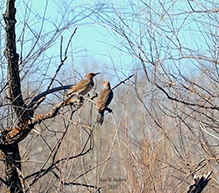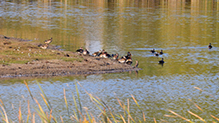Northern Flicker
(Colaptes auratus)
Conservation • Description • Habitat • Ecology • Distribution • Taxonomy
|
|
||||||||||||||
Description |
Northern Flicker is a common large woodpecker. Adults average 12½″ to 13″ in length with a 20″ wingspan. The body and wings are grayish-brown. The wings and back are barred. The tail is black on the top. The underside of the wings and tail are yellow. The rump, only visible in flight, is white. The breast and belly are buff to whitish and are heavily covered with black spots. The breast has a large black crescent. The crown and the nape of the neck are gray. There is a bright red crescent on the nape of the neck. The chin and throat are tan. The face is brownish to buff. The male has a prominent black mark behind the bill usually described as a “mustache stripe.” The bill is long. This bird is often seen flying away from the observer, making it impossible to see the head and neck markings. In these situations the white rump, conspicuous in flight, is the most useful identification mark. |
Size |
12½″ to 13″ in length 20″ wingspan |
Voice |
|
|
The song is a loud and rapid wick-wick-wick-wick-wick-wick. Each note bends upward. |
Similar Species |
Mourning Dove (Zenaida macroura) is similar in size and shape but not in coloration. When flying away it does not show a white rump. |
Habitat |
Open woodlands and forest edges, fields, and meadows; swamps in winter |
Ecology |
Migration |
Late February to late November |
Nesting |
Between February and July the male and female join together and excavate a new nest usually in a dead or dying deciduous tree, sometimes in a telephone pole or fence post. Less commonly, they will repair and reuse an existing cavity or use a birdhouse. Excavation takes about 2 weeks. The female lays 5 to 8 large, glossy white eggs. Both sexes incubate the eggs for 11 to 16 days, and after hatching, both sexes feed the young. Fledglings leave the nest 25 to 28 days after hatching. |
Food |
Mostly ants found on the ground. Also other insects, including grasshoppers, crickets, termites, wasps, aphids, beetles, beetle larvae, and caterpillars; spiders, In late fall and early spring they also eat cherries; berries, including dogwood, Virginia creeper, poison ivy, sumac, and hackberry; and nuts, including acorns. Overwintering individuals regularly visit suet feeders. |
Distribution |
Occurrence |
Common to abundant migrant and breeder |
Maps |
The Minnesota Ornithologists’ Union All Seasons Species Occurrence Map |
Taxonomy |
|
Class |
Aves (birds) |
Order |
Piciformes (woodpeckers, barbets, toucans, and honeyguides) |
Family |
Picidae (woodpeckers) |
Subfamily |
Picinae |
Genus |
Colaptes (flickers and allies) |
In 1995 the American Ornithologist’s Union (AOU) split the Northern Flicker into two species, Northern Flicker (Colaptes auratus) and Gilded Flicker (Colaptes chrysoides). |
|
Subordinate Taxa |
|
Some authorities, including the International Ornithologists’ Union (IOU), recognize ten subspecies (nine extant, one extinct). In this classification, Yellow Shafted Flicker (Colaptes auratus luteus) is the only subspecies found in Minnesota. Other authorities recognize only two subspecies. In this classification, Yellow Shafted Flicker (Colaptes auratus auratus) is the only subspecies found in Minnesota. |
|
auratus group (Yellow Shafted Flicker) Southeastern Yellow-shafted Flicker (Colaptes auratus auratus) Northern Yellow-shafted Flicker (Colaptes auratus luteus)
cafer group (Red Shafted Flicker) Northern Red-shafted Flicker (Colaptes auratus cafer) Southwestern Red-shafted Flicker (Colaptes auratus collaris) Mexican Red-shafted Flicker (Colaptes auratus mexicanus) Dwarf Red-shafted Flicker (Colaptes auratus nanus) Guadalupe Flicker (Colaptes auratus rufipileus) (extinct)
chrysocaulosus group (Cuban Flicker) Cuban Yellow-shafted Flicker (Colaptes auratus chrysocaulosus) Grand Cayman Flicker (Colaptes auratus gundlachi)
mexicanoides group (Guatemalan Flicker) Guatemalan Flicker (Colaptes auratus mexicanoides) |
|
Synonyms |
|
|
|
Visitor Photos |
||
Share your photo of this bird. |
||
This button not working for you? |
||
Dan W. Andree |
||
Northern Flickers... I seen these two northern flickers on 4-19-25 between Ada and Twin Valley in a wooded area not far from a pond. They would sit motionless then do a display called “fencing dual” from what I read. Pointed beaks in the air and moved their heads around making sounds then they would sit quiet for a short time then do it all over again. Fun to watch. |
||
Wood Ducks and a Northern Flicker at a pond... I was filming the wood ducks and a northern flicker flew into view and went over by the ducks. It was at a pond in Norman County Mn. 9-17-23. |
||
Bobbi Johnson |
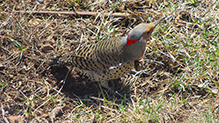 |
Gregory Gilman |
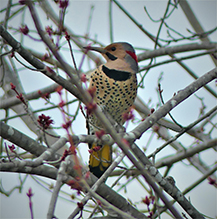 |
Audra Popp |
||
Just hanging out under the deck |
||
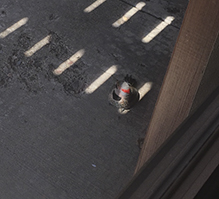 |
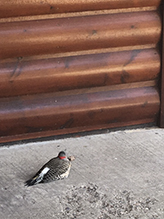 |
|
Wayne Rasmussen |
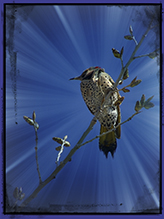 |
Northern Flicker (Yellowtail) at Breezy Point Resort 2011. Seen on the point north of the resort on Pelican Lake. |
Bill Reynolds |
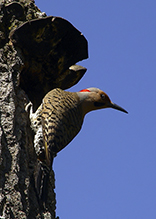 |
MinnesotaSeasons.com Photos |
||
|
||
|

Slideshows |
Northern Flicker |
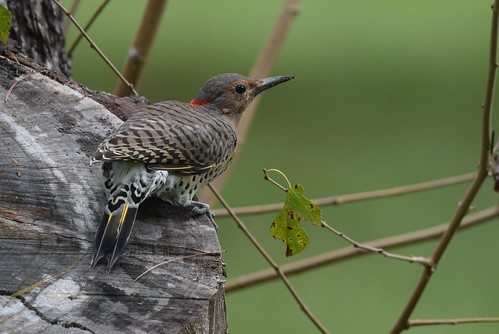
|
Yellow-shafted Flicker |
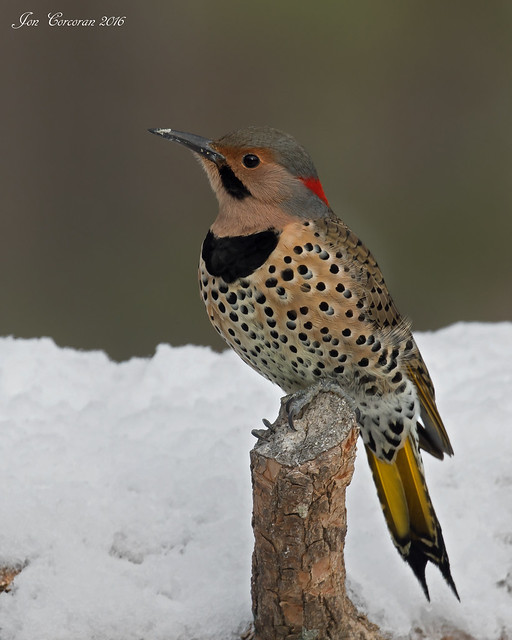
|
Northern Flicker |
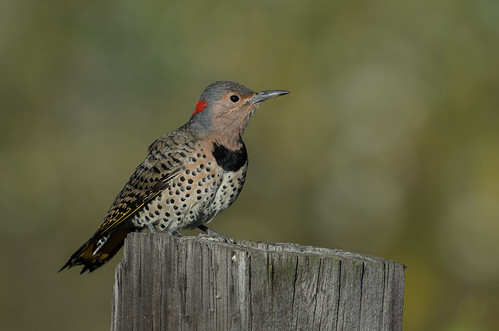
|

Visitor Videos |
||
Share your video of this bird. |
||
This button not working for you? |
||
Dan W. Andree |
"Northern Flicker Woodpeckers" Facing off Spring 2025 |
About
A short video of a couple of Northern Flicker Woodpeckers doing some interesting movements and making making sounds at each other. There was another flicker nearby but out of video range. First time I seen them do this. I only caught a little of it. Was interesting to see. |
Other Videos |
||
Northern Yellow-shafted Flicker Colaptes Auratus Auratus: Chicks Feed, Fly from Nest |
About
Published on Dec 2, 2013 This short video documents the lives of Northern (Yellow-Shafted) Flicker family over a 2 month period. Northern Flickers are ant eating woodpeckers that have a strong preference for nesting in tree cavities. Key Points: the stll at ~1:45 is a rare capture of the pair mating on a branch. The still at ~1:50 is an important part in the fledging process where the parent arrives at the nest to feed it's chicks and only feigns the feeding in hopes of luring it into leaving it's friendly confines. This causes the chicks to react aggressively in the midst of their hunger pang and the resultant a good peck to the stomach of the parent. If you look closely @ 7:33 and just after the chick's seventh chirp - you will see it fly from the nest. The still immediately following is of another chick leaving the nest. |
Yellow Shafted Flicker Tongue Action |
About
Published on Feb 23, 2011 It's amazing what happens when you slow down the movie (50X); one can see the tongue... Guest starring the tufted titmouse who demonstrates how to eat with ones feet... |
Yellow Shafted Flicker |
About
Uploaded on Jun 23, 2009 Feeding her young ones. Taken in my back yard |

Visitor Sightings |
||
Report a sighting of this bird. |
||
This button not working for you? |
||
Bobbi Johnson |
Location: Silver Bay, MN |
 |
| Dan W. Andree 9/17/2023 |
Location: Norman Co. Mn. I was filming the wood ducks and a northern flicker flew into view and went over by the ducks. It was at a pond in Norman County Mn. 9-17-23. |
 |
| Maggie E 9/2/2023 |
Location: Coon Rapids I live in a Mobile Home with Coon Creek in my back yard. The Creek is an extension of Mississippi River I have lived here for over 20 years & Flicker has pecked at my home for over 10 of those years. I use Black Crow for scare & put up reflection tape. It helped for a year or two. They also keep good time. I had one year that he started at exactly 9am . My last resort and hoping will help I purchased spikes to install on my siding. Keeping fingers crossed this will send him far away. Anyone with suggestions? |
|
| John Valo 9/2/2023 |
If the flicker is attempting to excavate a cavity for nesting, then putting up an appropriate birdhouse nearby might help. However, flickers also drill in search of food, drum to attract a mate, or drum to establish a territory. Here are some links with suggestions for managing them: How to Minimize Flicker Damage, Wild Birds Unlimited Northern Flicker – Biology and Damage Management, Utah State University Extension |
|
| Lisa D 1/22/2023 |
Location: Long Lake, MN It was sitting in a tree right near a window. We have 2 suet feeders out, so it was probably on one of them. Male. |
|
| Lora 1/21/2023 |
Location: Inver Grove Heights It was at our suet feeder. It would flap its wings while positioning on the feeder and its bright yellow underside of its wings was such a fun surprise. |
|
| Audra Popp 4/27/2020 |
Location: Royalton, Benton County Just hanging out under the deck |
 |
| Gregory Gilman 4/8/2020 |
Location: Rochester, MN |
 |
| Ben Walen 4/2 to 4/3/2020 |
Location: Minneapolis, Seward Neighborhood 2-3 in our yard |
|
| J Miller 4/17/2019 |
Location: Plymouth I have three of them hanging out. |
|
| Laura Nelson 4/7/2019 |
Location: Lakeville, MN sitting on our bird feeder pole & flew away into the trees |
|
Holly D |
Location: Slayton MN |
|
| Kim Niederkorn 4/24/2018 |
Location: Vermillion MN Yellow-shafted Flicker (Colaptes auratus luteus) |
|
| Kim Gustafson 10/29/2016 |
Location: Eagan, MN My first sighting of a Northern Flicker! He was eating "hearts and parts" bird seed out of my Squirrel Buster Plus feeder. |
|
Holly G |
Location: Middle Rice Creek in New Brighton MN |
|
| Wayne Rasmussen 5/3/2011 |
Location: Breezy Point Resort, Crow Wing County Northern Flicker (Yellowtail) at Breezy Point Resort 2011. Seen on the point north of the resort on Pelican Lake. |
 |
MinnesotaSeasons.com Sightings |
||

|
Created: 6/19/2009 Last Updated: © MinnesotaSeasons.com. All rights reserved. |
